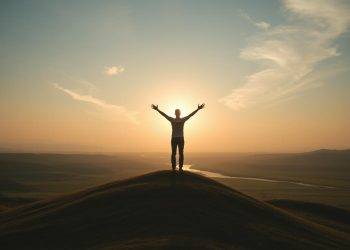“The secret of change is to focus all of your energy, not on fighting the old, but on building the new.” – Socrates
In today’s fast world, ancient wisdom guides us towards growth and self-discovery. Modern life often leads us to focus on ourselves alone. Yet, we need rituals that connect us, help us reflect, and improve our overall health.
By mixing old wisdom with today’s methods, we can build a practice that enriches our lives. This practice will care for our mind, body, and spirit.
The journey to self-improvement is about learning and growing. It’s not about being perfect. It’s about becoming better.
Whether you want to reduce stress, know yourself better, or reach your full potential, ancient wisdom and modern techniques can help. They can be a powerful tool for change.
Key Takeaways
- Explore the timeless wisdom of ancient healing traditions and their relevance to modern personal growth practices.
- Discover how to cultivate a holistic self-improvement practice by blending ancient rituals and modern mindfulness techniques.
- Understand the importance of creating meaningful rituals and routines to foster greater self-awareness, connection, and overall well-being.
- Learn to overcome common obstacles and challenges in your personal growth journey by drawing upon the resilience of ancient wisdom.
- Develop a personalized ritual framework that aligns with your unique needs and supports your transformation.
Understanding the Power of Ancient Wisdom in Personal Development
Throughout history, many cultures have shared deep insights into human nature. These insights offer timeless wisdom for personal growth and change. By looking into these ancient traditions, we can learn valuable lessons for our personal development journey and grow in self-awareness.
The Historical Significance of Healing Traditions
Ancient healing practices have shaped today’s healthcare. They have influenced medical philosophies and treatments. Shamanic traditions taught us to connect with nature and unseen forces, focusing on the balance of mind, body, and spirit.
The Hippocratic Corpus started clinical medicine, focusing on symptoms, prognosis, and treatment outcomes. Ayurveda, which combines mental, physical, and spiritual harmony, is now recognized as a helpful treatment.
Bridging Ancient Practices with Modern Needs
Today, ancient healing methods are being used in modern medicine. Holistic and complementary medicine use techniques like acupuncture, herbal medicine, and mindfulness meditation. These methods help with goal-setting strategies and tackle today’s health issues.
By mixing ancient wisdom with modern science, we can grow and improve our well-being in a more complete way.
The Role of Ritual in Human Evolution
Rituals have always been important to humans, connecting us to the physical and metaphysical worlds. From shamanic ceremonies to modern spiritual practices, rituals help us grow. They help us connect deeply, discover hidden parts of ourselves, and tap into forces that shape our evolution.
| Ancient Wisdom | Core Principles |
|---|---|
| Socrates’ “Know Thyself” | Promoting self-awareness and understanding of strengths, weaknesses, and values |
| Bhagavad Gita | Teachings on balance and moderation to achieve harmony in life |
| Tao Te Ching | Promoting present moment awareness, leading to clarity and peace |
| Confucianism | Emphasizing integrity, ethical behavior, and meaningful connections |
| Buddhism | Highlighting impermanence, resilience, and adaptability in the face of change |
Exploring ancient wisdom can reveal powerful insights for our personal development journey and self-awareness. These goal-setting strategies help us face modern life with clarity, resilience, and purpose.
Creating a Personal Growth Practice: Foundation and Principles
Building a personal growth practice starts with a strong foundation and key principles. At its core is an empowering growth mindset. This mindset lets you see challenges as chances to learn and grow, not as things to avoid. It helps you overcome challenges, build resilience, and reach your full potential.
The 4P formula for success is a key principle: Plan, Prepare, Practice, and Perform. This formula helps you set clear goals, align your actions, and practice consistently. Using time management techniques like the Pomodoro method and the Eisenhower Matrix also boosts your productivity.
Embracing a growth mindset also means being kind to yourself, learning from mistakes, and always looking for ways to improve. Positive affirmations and regular check-ins with your progress can help keep you focused and motivated.
| Personal Growth Activities | Benefits |
|---|---|
| Mindfulness practices (meditation, breathwork) | Improved mental clarity, emotional balance, and stress management |
| Gratitude journaling | Transformed outlook on life and enhanced well-being |
| Communication skill development (active listening, public speaking) | Stronger relationships and improved self-expression |
| Continuous learning (online courses, reading) | Expanded knowledge, career opportunities, and personal fulfillment |
By following these foundational principles and trying different personal growth activities, you start a journey of self-discovery. Remember, personal growth is a lifelong journey. Celebrating small wins keeps you motivated and moving forward.

The Three Phases of Transformational Rituals
Starting your personal growth journey is easy with transformational rituals. These rituals, filled with ancient wisdom, have three key steps: disruption, transformation, and re-patterning. They help you grow and find your true self.
Disruption: Breaking Old Patterns
The first step, disruption, is about breaking free from old habits. It can start with a big life change or by entering a special ritual space. This step opens the door to personal growth and change.
Transformation: Embracing Change
In the transformation phase, you change how you see things that are gone or no longer work for you. This can be tough, as you leave behind what’s familiar and step into the unknown. It’s a chance to discover who you are and what’s possible.
Re-patterning: Integrating New Behaviors
The last step, re-patterning, is about making sense of your ritual and the changes you’ve made. It’s key to making these changes a part of your everyday life. By choosing the right symbols and experiences, you can smoothly adopt new ways of thinking and acting.
Remember, personal growth is a journey that never ends. Using transformational rituals can be a powerful way to grow. By breaking old patterns, changing your mind, and adopting new behaviors, you can reach your full potential and live a fulfilling life.
Sacred Symbolism and Personal Growth Tools
On your journey of personal growth, sacred symbols can change your life. These symbols and images are key in rituals that help us grow and find ourselves. By grasping their meaning, you can connect more deeply with your mindfulness techniques and personal development journey. This leads to unlocking your potential.
There are two main types of symbolic objects in personal transformation rituals. Linking/transitional objects help us deal with feeling left out. Melancholy objects start as everyday things but become special and memorable. These tools help us accept change and loss, leading to new meanings and connections.
Symbolic images can also come from dreams, daydreams, and art. Techniques like Active Imagination, created by Carl Jung, help bring these images to the surface. This method helps choose meaningful ritual objects and boosts your creativity for self-discovery.
“Spiritual growth enhances well-being by promoting emotional balance, reducing stress, and improving mental health.”
Embracing sacred symbolism is a deep way to enrich your personal development journey. By adding these symbols to your rituals, you can feel more connected to yourself. This leads to better mindfulness techniques and faster personal growth.
Kaizen: The Art of Continuous Self-Improvement
Exploring Kaizen, the Japanese way of continuous improvement, can change your life. It’s about making small steps, not big changes. This approach helps you build lasting self-improvement habits.
Understanding Kaizen Philosophy
Kaizen means “change for the better.” It’s about making small, steady progress. It’s not about setting huge goals. Instead, it’s about making small, easy changes every day.
Daily Practices for Incremental Growth
- Prioritize solitude and personal reflection
- Incorporate physical activity and live nourishment into your day
- Dedicate time to acquiring new knowledge and skills
- Cultivate a congruent character through self-awareness
- Simplify your environment to create space for growth
By doing these self-improvement habits every day, you’ll see progress. You’ll get better at setting and reaching goals.
Measuring Progress and Adaptation
Having a growth mindset is key to Kaizen. It’s important to check your progress, celebrate small wins, and adjust your path as needed. This keeps you motivated and moving forward.
| Kaizen in Action | Key Outcomes |
|---|---|
| Adopting a daily routine of solitude, physical activity, and knowledge acquisition | Improved mental clarity, physical well-being, and expanded personal knowledge |
| Simplifying your living and working environment | Increased focus, reduced stress, and more space for growth |
| Regularly reviewing and adjusting your self-improvement goals | Increased adaptability, better alignment with evolving needs, and sustained progress |
By following the Kaizen philosophy and these daily practices, you can improve continuously. You’ll reach your personal growth goals more easily and with more joy.
Mindfulness and Ritual Integration
Exploring mindfulness techniques and rituals can change your life. Ancient healing traditions, like shamanic practices, showed the power of spiritual and mental health. These practices used drumming, chanting, or dance to help people connect and understand themselves better.
Today, mindfulness meditation is widely accepted as a helpful tool for mental health. Adding mindfulness to your daily routines can improve your self-awareness and emotional control. It also helps you connect more deeply with yourself and the world around you.
“Ritual creation is a part of the author’s job due to insights unearthed in morning writing sessions. Many individuals have lost the skill of creating meaningful ritual, turning to Pinterest and Instagram for ideas.”
Creating a meaningful ritual is more than just following a plan. It starts with thinking about what you want to achieve and summing it up in one word. Then, brainstorming actions or processes that fit your intention is key to making it real.
- The timing and space chosen for a ritual can be as impactful as the ritual itself.
- Integrating sensory elements into a ritual can help individuals feel its intention in a deeply somatic way.
- Rituals often involve community building and may require the support of loved ones.
- Building a ritual may involve taking time to consider each step and personalize the process.
By adding mindfulness techniques to your daily routines, you can grow in a deep way. This mix of mindfulness and rituals can change your life, opening up new levels of understanding and self-discovery.

Overcoming Challenges in Your Growth Journey
The journey to personal growth is not always easy. You will meet challenges that test your strength and will. But these challenges can also lead to deep self-discovery and growth.
Common Obstacles and Solutions
Many people face challenges on their personal growth path. These include:
- Lack of time or competing priorities
- Overwhelming feelings of self-doubt or fear
- Difficulty maintaining consistent practices or habits
- Resistance to change or stepping out of one’s comfort zone
To beat these challenges, you need a plan. Set clear goals, make a plan, and surround yourself with support. Getting advice from mentors, joining online groups, and using helpful tools can also help a lot.
Building Resilience Through Practice
Being resilient is key to overcoming obstacles. By sticking to personal growth habits, you build inner strength. Seeing challenges as chances to learn and grow helps you stay strong.
Adapting Ancient Wisdom for Modern Challenges
In today’s world, ancient wisdom can guide you. By using old practices for new problems, you find solutions that fit your goals. This mix of old and new helps you tackle modern challenges.
Remember, challenges are not just hurdles. They are chances to grow and learn. By being resilient, seeking help, and using ancient wisdom, you can turn obstacles into stepping stones to growth and happiness.
Creating Your Personal Ritual Framework
Creating a personal ritual framework is key to unlocking your full potential. It aligns with your unique needs and aspirations. Drawing from ancient wisdom and modern self-improvement techniques, you can design a practice that supports your growth.
Your ritual framework should focus on continuous improvement, like the Kaizen philosophy. Include daily rituals for your physical, mental, and emotional health. These can be solitude, movement, nourishment, learning, reflection, and simplification. Together, they form a powerful routine for personal growth and goal-setting.
Your ritual framework should reflect your unique needs and preferences. Try different elements, track your progress, and adjust it as needed. This way, it will always support your journey to unlock your potential. By blending ancient wisdom with modern insights, you can create a ritual that empowers you to succeed in today’s world.
FAQ
What is the historical significance of ancient healing traditions?
Ancient healing traditions, like shamanism and Hippocratic medicine, have shaped health care for thousands of years. They have influenced how we think about health and wellness today. This includes holistic and complementary medicine.
How have ancient practices influenced contemporary healthcare?
Ancient healing practices have greatly shaped today’s healthcare. They have influenced medical philosophies and treatments. Practices like acupuncture, herbal medicine, and mindfulness meditation are now accepted as helpful additions to traditional treatments.
What are the key components of a transformational ritual?
Transformational rituals have three main parts: disruption, transformation, and re-patterning. These steps are based on studies of rites of passage. They are key to creating a controlled transformation.
How can symbolic objects be used in personal growth rituals?
Symbolic objects, like linking objects and melancholy objects, are vital in personal growth rituals. They help us accept loss and open up to new meanings and attachments.
What is the Kaizen approach to personal growth?
Kaizen is the Japanese art of continuous improvement. It involves using rituals in daily life to stay focused on meaningful growth. Activities like solitude, physical activity, eating well, and reflection are part of this.
How can mindfulness be integrated into personal growth practices?
Mindfulness meditation, rooted in ancient healing, is now seen as a valuable addition to traditional treatments. Adding mindfulness to daily rituals can improve self-awareness and emotional control. It helps us connect with ourselves and the world around us.
What are some common challenges in personal growth and how can they be overcome?
Overcoming personal growth challenges requires addressing issues like cultural appropriation and commercialization. Building resilience through consistent practice is key. Adapting ancient wisdom to modern challenges, like stress and work-life balance, helps overcome these obstacles.
How can you create a personalized ritual framework for your growth journey?
To create a personal ritual framework, mix ancient wisdom with modern self-improvement. Tailor it to your needs and preferences. Daily rituals for solitude, physical activity, nourishment, learning, reflection, and simplification can be part of this framework.




























































